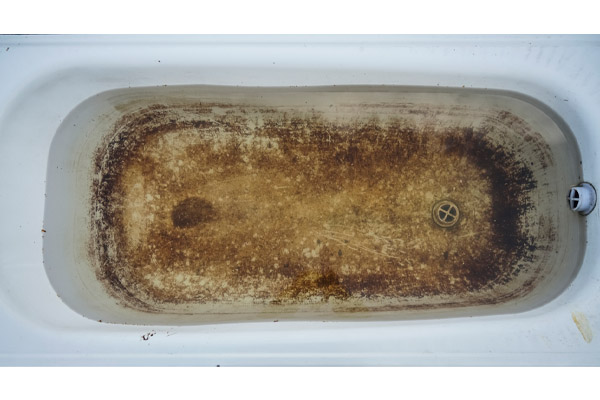My Definitive Explanation: Waste Coming Up Through the Bathtub
My Definitive Explanation: Waste Coming Up Through the Bathtub
Blog Article
We've unearthed the article about Why is There Sewage Coming Up Through the Bathtub down the page on the internet and figured it made sense to write about it with you over here.

Sewage backup in the bathtub can be a traumatic and unhygienic issue for any kind of homeowner. Not just is it inconvenient, yet it likewise positions significant health dangers and shows underlying issues with the plumbing system. Understanding why sewage is turning up through the tub is essential for taking proper action to attend to the trouble properly.
Introduction to the Issue
Understanding the Issue
When sewage draws back up into the bathtub, it's a clear sign of a problem with the water drainage system. The wastewater that must be moving away from your home is rather locating its back right into your home, which can result in significant damage and carcinogen.
Potential Causes
A number of aspects can contribute to sewer back-up in the bath tub. From obstructions in the drain line to issues with the plumbing framework, determining the source is crucial for locating a remedy.
Usual Reasons for Sewer Back-up
Clogs in the Drain Line
Among the most typical root causes of sewage back-up is an obstruction in the sewage system line. This can occur because of the buildup of particles, grease, or foreign objects in the pipes, stopping correct flow and causing sewage to back up into your bathtub.
Tree Root Intrusion
Tree origins looking for wetness and nutrients can infiltrate sewage system lines via little cracks or joints. Over time, these origins can grow and expand, creating substantial damage to the pipes and leading to sewage back-up problems.
Aging Framework
Older homes might have outdated plumbing systems that are a lot more prone to rust, splits, and wear and tear. As pipelines age, they come to be extra susceptible to leakages and obstructions, raising the possibility of sewer back-up incidents.
Heavy Rainfall or Flooding
Throughout periods of heavy rainfall or flooding, the sewer system might become overloaded with excess water, causing back-ups and overflows. This can lead to sewer backing up into tubs and various other components inside the home.
Wellness Risks Related To Sewer Back-up
Contamination of Water System
Sewer back-up can contaminate the water in your house, posturing a serious wellness danger to you and your household. Direct exposure to infected water can result in stomach problems, skin infections, and other illnesses.
Spread of Illness
Sewer has damaging microorganisms, infections, and parasites that can trigger a series of conditions, including hepatitis, cholera, and gastroenteritis. Entering contact with sewer or infected surface areas puts you at risk of infection.
Mold Growth
Dampness from sewer backup can develop optimal problems for mold growth in your home. Mold spores can aggravate respiratory system problems and create allergic reactions in sensitive people, making punctual clean-up essential.
Signs of Sewage Back-up
Foul Odors
Unpleasant odors emanating from drains pipes or components, specifically in the shower room, may show sewage backup problems. These odors are typically solid and relentless, indicating an issue that needs instant attention.
Slow Draining Fixtures
Bathtubs, sinks, and toilets that drain pipes slowly or otherwise in all could be experiencing sewer backup. If multiple components are affected concurrently, it's likely that the concern originates from a common factor, such as the primary sewer line.
Gurgling Sounds
Unusual gurgling or gurgling sounds originating from drains pipes when water is running in other places in your home are a measure of air trapped in the plumbing system. This air build-up can arise from sewage back-up and should be checked out promptly.
Immediate Actions to Take
Switching Off Water System
In the event of sewer backup, it's necessary to switch off the water system to prevent more contamination and damages. Find the primary water shutoff valve in your home and shut it off till the concern can be dealt with.
Calling an Expert Plumber
Managing sewer backup is not a DIY task. Call an accredited plumber with experience in managing sewage-related problems to assess the scenario and perform required fixings or clean-ups.
Preventing Contact with Polluted Water
Up until the sewage backup is dealt with, avoid contact with contaminated water to prevent the spread of microorganisms and virus. Wear protective equipment if you must be in the affected area and wash your hands completely afterward.
Safety nets
Routine Upkeep of Sewage System Lines
Arrange routine assessments and maintenance of your sewage system lines to determine and address possible concerns prior to they escalate right into major problems. This can consist of clearing out particles, checking for tree origin intrusion, and repairing any damaged pipes.
Mounting Backwater Valves
Think about installing bayou shutoffs in your plumbing system to stop sewage from receding right into your home during periods of heavy rainfall or flooding. These valves automatically close when water draws back up, protecting your home from contamination.
Correct Disposal of House Waste
Stay clear of purging anything other than toilet paper and human waste down the toilet to avoid clogs and obstructions in the sewer line. Dispose of oil, oil, and other home chemicals correctly to lessen the risk of plumbing issues.
Tidying up After Sewage Back-up
Disinfection Procedures
Completely sanitize and sanitize affected locations after sewer back-up to remove dangerous microorganisms and stop mold growth. Usage appropriate cleaning products and safety equipment to ensure risk-free and efficient cleaning.
Restoration of Impacted Areas
Fix any kind of damage to flooring, wall surfaces, or fixtures caused by sewage back-up. Depending on the level of the damage, you might need to change carpeting, drywall, or other products to recover your home to its pre-loss condition.
Why Is Water Backing Up in My Bathtub When I Flush My Toilet?
What to do about a sewer line clog
First, don’t bother with plunging. No amount of plunging will dislodge the clog in a sewer line. The clog is too far away. Plungers are for clogs in the toilet itself, not the sewer line. Plus, the most likely causes of a sewer clog are:
Tree roots Flushed toys or feminine products Grease buildup Those items don’t move easily. And in the case of tree roots, the roots need to be cut out of the pipe and the pipe will need to be repaired.
You’ll need a closet auger. A closet auger is a type of plumber’s snake with a protective cover to keep from scratching the delicate porcelain toilet. If the clog is further down, you may need to remove the toilet or use one of your cleanouts to get to the clog.
We also recommend doing a video inspection of the drain to ensure that the cause of the clog has been completely removed. Otherwise, you could have the same problem again in a few days or weeks.
https://mspplumbingheatingair.com/blog/why-is-water-backing-up-in-my-bathtub-when-i-flush-my-toilet

I'm just very occupied with Why is There Sewage Coming Up Through the Bathtub and I'm hoping you appreciated the blog post. Don't hesitate to take the opportunity to share this post if you liked it. We thank you for your readership.
Book-Now
Report this page